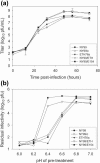Envelope protein glycosylation status influences mouse neuroinvasion phenotype of genetic lineage 1 West Nile virus strains
- PMID: 15956579
- PMCID: PMC1143769
- DOI: 10.1128/JVI.79.13.8339-8347.2005
Envelope protein glycosylation status influences mouse neuroinvasion phenotype of genetic lineage 1 West Nile virus strains
Abstract
The introduction of West Nile virus (WNV) into North America has been associated with relatively high rates of neurological disease and death in humans, birds, horses, and some other animals. Previous studies identified strains in both genetic lineage 1 and genetic lineage 2, including North American isolates of lineage 1, that were highly virulent in a mouse neuroinvasion model, while other strains were avirulent or significantly attenuated (D. W. C. Beasley, L. Li, M. T. Suderman, and A. D. T. Barrett, Virology 296:17-23, 2002). To begin to elucidate the basis for these differences, we compared a highly virulent New York 1999 (NY99) isolate with a related Old World lineage 1 strain, An4766 (ETH76a), which is attenuated for mouse neuroinvasion. Genomic sequencing of ETH76a revealed a relatively small number of nucleotide (5.1%) and amino acid (0.6%) differences compared with NY99. These differences were located throughout the genome and included five amino acid differences in the envelope protein gene. Substitution of premembrane and envelope genes of ETH76a into a NY99 infectious clone backbone yielded a virus with altered in vitro growth characteristics and a mouse virulence phenotype comparable to ETH76a. Further site-specific mutagenesis studies revealed that the altered phenotype was primarily mediated via loss of envelope protein glycosylation and that this was associated with altered stability of the virion at mildly acidic pH. Therefore, the enhanced virulence of North American WNV strains compared with other Old World lineage 1 strains is at least partly mediated by envelope protein glycosylation.
Figures


References
-
- Beasley, D. W. C., L. Li, M. T. Suderman, and A. D. T. Barrett. 2001. West Nile virus strains differ in mouse neurovirulence and binding to mouse or human brain membrane receptor preparations. Ann. N. Y. Acad. Sci. 951:332-335. - PubMed
-
- Beasley, D. W. C., L. Li, M. T. Suderman, and A. D. T. Barrett. 2002. Mouse neuroinvasive phenotype of West Nile virus strains varies depending upon virus genotype. Virology 296:17-23. - PubMed
-
- Beasley, D. W. C., C. T. Davis, H. Guzman, D. L. Vanlandingham, A. P. A. Travassos da Rosa, R. E. Parsons, S. Higgs, R. B. Tesh, and A. D. T. Barrett. 2003. Limited evolution of West Nile virus has occurred during its southwesterly spread in the United States. Virology 309:190-195. - PubMed
-
- Beasley, D. W. C., C. T. Davis, M. Whiteman, B. Granwehr, R. M. Kinney, and A. D. T. Barrett. 2004. Molecular determinants of virulence of West Nile virus in North America. In C. H. Calisher and D. E. Griffin (ed.), Emergence and control of zoonotic viral encephalitides. Arch. Virol. Suppl. 18:35-41. - PubMed
Publication types
MeSH terms
Substances
Grants and funding
LinkOut - more resources
Full Text Sources
Other Literature Sources
Medical
Molecular Biology Databases

